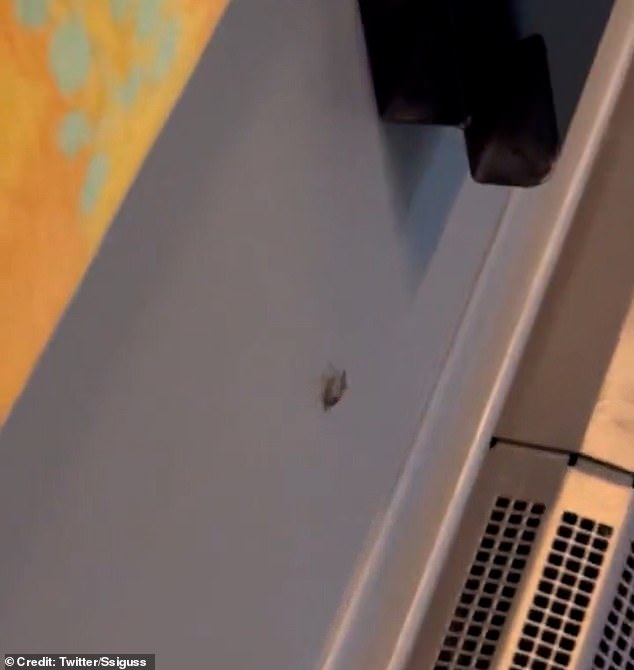Arsenic. Gunpowder. Burning a bale of straw in your bedroom. How they tackled bedbugs in the good old days!
Visitors to medieval Paris had no doubt that the city was in the grip of a poisonous plague.
The bedrooms, they were told, were infested with small black creatures, which at night “sat on the faces of those who slept” and “stung them hard.”
The situation was so serious that a 14th-century guidebook titled Le Menagier de Paris, loosely translated as The Good Wife’s Guide to the French Capital, devoted two pages to the problem.
Readers were advised to scatter alder leaves on the floor of their bedroom or lay out two slices of bread ‘smeared with glue or turpentine’ and lit by candles.
Alternatively, sheepskins can be used to attract them, which can then be confined in an airtight box until suffocation is thought to occur.

Today, wellness guru Ann Ziety shares how to stay calm during the upcoming bed bug invasion (stock image)
If none of these methods worked, there was always the option of setting fire to a pile of hay in the middle of your bedroom – with the not insignificant risk of burning your house down.
Fast forward 600 years and the problem is as serious as ever. And it’s not just Paris that has fallen victim to bedbugs.
The modern world, filled with people who are constantly on the move thanks to the proliferation of low-cost airlines and the convenience of Airbnb, is tailor-made for their proliferation.
Every city that has hosted Rugby World Cup matches, from Lyon to Marseille, is reporting outbreaks and the country appears to be suffering a collective nervous breakdown as a result.
Social media is saturated with photos of les punaises de lit everywhere, from high-speed trains to the seats at Charles de Gaulle airport. Many travelers on the Paris Metro insist on standing for the entire journey, for fear of picking up one of the little critters along the way and taking it home.
Meanwhile, a video posted online from a back street in Marseille shows piles of mattresses and other home furnishings dumped by householders desperately trying to get rid of the notoriously difficult-to-kill mites. Such is the hysteria over the outbreak that some fans staying overnight for England’s semi-final against South Africa at the Stade de France in Paris tomorrow are reportedly bringing their own bedding.

Video footage shared online shows the insects crawling over seats on the Paris metro, high-speed trains and at Paris’s Charles-de-Gaulle airport
It may be tempting to wallow in the discomfort of our French cousins, but the bad news is that the problem has already crossed the Channel.
The HMRC building in Ipswich has been invaded by leeches – which some unkind people say is an example of our tax collectors getting a taste of their own medicine.
But the truth is, we’ve been scratching and itching for thousands of years. Bed bugs have been around long before bedtime – and even people.
In 2019, the University of Dresden published evidence that fossilized remains of bed bugs date back to the age of the dinosaurs – although it is thought they are more likely to have feasted on small mammals than herds of Tyrannosaurus rex.
Once they turned their attention to humans, a long journey of discovery began, aimed at the fastest and easiest way to get rid of them – an odyssey that continues to this day. One of the first people to devote his planet-sized brain to the subject was the Ancient Greek philosopher Democritus in 400 BC, who is said to have first come up with the theory that the world consisted of atomic particles. Unfortunately, his idea of hanging a hare or deer’s feet at the foot of your bed to ward them off was a non-starter.
The Romans proved no more effective. Legend has it that in AD 64, Emperor Nero caused the Great Fire of Rome by lighting a fire to tackle the bedbugs that had kept him awake. Thanks to Britain’s island status, it would be hundreds of years before we became victims.

Sniffer dogs, steam cleaning and chemical treatments have all failed to eliminate the infestation at Brooke Lawrance House (pictured)
As we have seen, bed bugs tormented the residents of Paris in the 14th century.
But in the absence of Eurostar and rugby fans, it appears they took another two centuries to cross the Channel, with the first recorded bites dating back to 1583.
However, the bed bugs quickly made up for lost time. In 1690 they had even reached the royal house.
That year, advertisements appeared for a London company called Tiffin & Son, which billed themselves as ‘Bug-Destroyers to Her Majesty’ – presumably Mary II, who occupied the throne jointly with William III. “May the destroyers of peace be destroyed by us,” was the company slogan.
Perhaps unsurprisingly, it wasn’t long before the finger was pointed at the great unwashed. In 1730 a pamphlet entitled A Treatise Of Buggs appeared on the streets, in which author John Southall gave advice to the well-to-do: ‘If you have occasion to change servants, let their boxes, trunks &c. let yourself be thoroughly examined before you take them to your rooms.’
He went on to say, ‘Let no washerwoman’s basket be brought into your houses; for they often prove dangerous to those who have no bugs.”
The proliferation of bed bugs continued despite an impressive arsenal of techniques used against them; methods that sometimes proved fatal to the householder than to the insects themselves.
Southall himself advocated – and sold for a shilling a bottle – a Nonpareil liqueur for which he claimed he had obtained the secret recipe from Jamaica.
When that turned out to have little effect, society switched to the really risky matters. A 1777 pamphlet entitled The Complete Vermin Killer advised filling cracks in the woodwork of your bedstead with gunpowder and setting it on fire.
Wise people began replacing their wooden bedsteads with iron limbs, which do not have bedbug-friendly cracks.
By the 19th century, things had progressed to the point where chemists were selling bedbug poison – a deadly preparation of mercuric chloride, which householders were told they could spray, brush or apply to their furniture with a feather. It turned out to be terribly poisonous to humans.
In 1901, after authorities in San Francisco fumigated properties with mercuric chloride in an attempt to rid the city’s Chinatown of insect infestations, they became uninhabitable for years afterward.
Bed bug patients were also given arsenic preparations, some of which – in the style of Agatha Christie – was used to get rid of another type of pest: relatives who stood in the way of a large inheritance, for example.
Then there were the pyrotechnic solutions. The ‘fire-and-brimstone’ method involved burning sulfur on the bedroom floor, creating a hissing mass that gave off sulfur dioxide – a treatment that, users complained, bleached the wallpaper. You hate to think what it did to their lungs.
And still bed bugs persisted. In 1934 the Ministry of Health reported that there was hardly a house in London that was not affected by bedbugs at some time during the year.
World War II made matters worse, with people helping to spread the contagion by taking their bedding to overcrowded air raid shelters.
But then came a miracle cure: the widespread availability of the pesticide DDT beginning in the late 1940s allowed buildings to be properly rid of bedbugs.

Bed bug bites leave red marks, blisters or large rashes on the skin and can cause intense itching or allergic reactions
While previous poisons had only killed insects that came into direct contact with it, DDT – applied to walls, floors and ceilings – remained fatal for months to any bedbug that crawled over it.
It was too good to last. In 1962, conservationist Rachel Carson published a groundbreaking work called Silent Spring, which exposed the toxic environmental consequences of the widespread use of pesticides. The writing was on the wall for DDT and by the 1980s its use was banned in most developed countries.
By the end of the 20th century, bed bugs were back.
According to Rentokil, the number of bedbugs in Britain has increased by 65 percent in the past 12 months, due to growing resistance to insecticides and a return to pre-pandemic travel levels.
With chemicals out of favor, methods such as steam treatment, freezing CO2 sprays and heat guns are now the favored ‘mechanical solutions’ for killing bed bugs and their eggs.
But it seems safe to assume that we will never be free of it for long. Like rats, they are bedfellows of human civilization.
